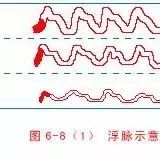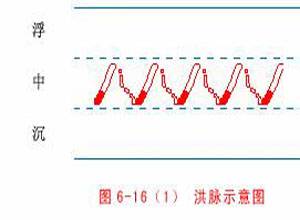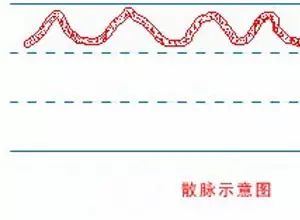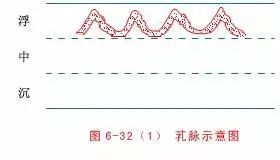

(1)Floating Pulse Types
The floating pulse types include six pulses: Fu (Floating), Hong (Surging), Ru (Soft), San (Scattered), Kao (Hollow), and Ge (Leather). These pulses are characterized by their superficial position, easily felt upon light pressure.

Fu Pulse (Floating Pulse)
【Pulse Pattern】: Easily felt with light pressure, slightly reduced with heavy pressure but not empty, feels abundant like wood floating on water.
【Main Disease】: Exterior syndrome, deficiency syndrome.
【Pulse Theory】: The Fu pulse indicates an exterior condition, reflecting the pathogenic factor in the meridians and superficial layers. The pathogen invades the muscles, and the defensive Yang rises to resist, causing the pulse to be strong and floating. In cases of chronic illness with deficiency, the Yang cannot sink and remains floating, resulting in a weak Fu pulse.

Hong Pulse (Surging Pulse)
【Pulse Pattern】: Extremely large, resembling surging waves, strong on arrival and weak on departure.
【Main Disease】: Interior heat syndrome.
【Pulse Theory】: The Hong pulse forms due to excess Yang, Qi stagnation, and internal heat, causing the pulse vessels to expand and blood to surge. If seen in chronic deficiency or blood loss, it indicates a dangerous condition of deficiency with excess pathogenic factors or depletion of Yin fluids.

Ru Pulse (Soft Pulse)
【Pulse Pattern】: Floating and fine, like silk in water.
【Main Disease】: Deficiency syndrome, damp syndrome.
【Pulse Theory】: The Ru pulse indicates various deficiencies. If both essence and blood are depleted, Yin cannot support Yang, resulting in a soft and fine pulse. If dampness obstructs the pulse vessels, a Ru pulse may also be observed.

San Pulse (Scattered Pulse)
【Pulse Pattern】: Floating and scattered, lacking root, with irregular beats, resembling scattered willow fluff.
【Main Disease】: Dispersed vital energy.
【Pulse Theory】: The San pulse indicates a critical condition where the vital energy is dispersed, often due to heart failure, where Yin and Yang cannot stabilize, leading to a floating and scattered pulse.

Kao Pulse (Hollow Pulse)
【Pulse Pattern】: Floating, large, and hollow, like pressing on a scallion tube.
【Main Disease】: Blood loss, Yin injury.
【Pulse Theory】: The Kao pulse is often seen in cases of blood loss and Yin injury, indicating a lack of filling in the pulse vessels due to sudden blood loss or severe fluid depletion.
Ge Pulse (Leather Pulse)
【Pulse Pattern】: Floating and firm, hollow on the inside, like pressing on a drum skin.
【Main Disease】: Blood loss, loss of essence, postpartum issues.
【Pulse Theory】: The Ge pulse is a combination of the Xian and Kao pulses, indicating internal deficiency of essence and blood, with the pulse appearing strong externally but hollow internally.
(2)Deep Pulse Types
The deep pulse types include four pulses: Chen (Deep), Fu (Hidden), Ruo (Weak), and Lao (Firm). These pulses are characterized by their deeper position, requiring heavy pressure to be felt.
Chen Pulse (Deep Pulse)
【Pulse Pattern】: Not felt with light pressure, only with heavy pressure, like a stone sinking to the bottom of water.
【Main Disease】: Interior syndrome. Can also be seen in healthy individuals.
【Pulse Theory】: The Chen pulse indicates that the pathogenic factor is internal, with the vital energy struggling internally, leading to a strong deep pulse in cases of excess. If the organs are weak, the pulse may be deep and weak, indicating internal deficiency.
Fu Pulse (Hidden Pulse)
【Pulse Pattern】: Requires heavy pressure to feel, may be hidden and not felt at all.
【Main Disease】: Closed pathogenic factors, critical conditions, severe pain.
【Pulse Theory】: The Fu pulse occurs when pathogenic factors are hidden, preventing the pulse from being expressed. If Yang is severely deficient, the pulse may also be hidden.
Ruo Pulse (Weak Pulse)
【Pulse Pattern】: Extremely soft and fine.
【Main Disease】: Deficiency of Qi, blood, Yin, and Yang.
【Pulse Theory】: The Ruo pulse indicates insufficient Yin and blood, leading to a weak pulse that cannot support blood flow.
Lao Pulse (Firm Pulse)
【Pulse Pattern】: Deep, firm, and long, solid and unyielding.
【Main Disease】: Cold accumulation, internal solid masses.
【Pulse Theory】: The Lao pulse indicates a solid internal condition, with cold accumulation and Yang energy sinking, resulting in a firm and deep pulse.
(3)Slow Pulse Types
The slow pulse types include four pulses: Chi (Slow), Huan (Relaxed), Se (Choppy), and Jie (Knotted). These pulses are characterized by a slow rhythm, with fewer than four beats per breath.
Chi Pulse (Slow Pulse)
【Pulse Pattern】: The pulse is slow, with fewer than four beats per breath (equivalent to less than 60 beats per minute).
【Main Disease】: Cold syndrome. Strong Chi indicates cold pain, weak Chi indicates deficiency cold.
【Pulse Theory】: The Chi pulse indicates a cold condition due to insufficient Yang energy, leading to a slow pulse. If cold accumulates, the pulse may be strong; if Yang is deficient, the pulse is weak.
Huan Pulse (Relaxed Pulse)
【Pulse Pattern】: Four beats per breath, with a relaxed rhythm.
【Main Disease】: Damp syndrome, spleen and stomach weakness.
【Pulse Theory】: The Huan pulse indicates dampness obstructing the Qi mechanism, leading to a relaxed pulse due to insufficient Qi and blood.
Se Pulse (Choppy Pulse)
【Pulse Pattern】: Slow, fine, and short, with irregular beats, difficult to flow.
【Main Disease】: Deficiency of essence and blood, Qi stagnation, phlegm, and food retention.
【Pulse Theory】: The Se pulse indicates insufficient essence and blood, leading to a choppy pulse. Qi stagnation, phlegm, and food retention can also cause a choppy pulse.
Jie Pulse (Knotted Pulse)
【Pulse Pattern】: The pulse is slow, with intermittent stops.
【Main Disease】: Excessive Yin, Qi stagnation, cold phlegm, and blood stasis.
【Pulse Theory】: The Jie pulse indicates excessive Yin obstructing the Qi mechanism, leading to a slow and knotted pulse.
(4)Rapid Pulse Types
The rapid pulse types include four pulses: Shu (Rapid), Ji (Hasty), Cu (Skipping), and Dong (Moving). These pulses are characterized by a fast rhythm, with more than five beats per breath.
Shu Pulse (Rapid Pulse)
【Pulse Pattern】: More than five beats per breath.
【Main Disease】: Heat syndrome. Strong Shu indicates excess heat, weak Shu indicates deficiency heat.
【Pulse Theory】: The Shu pulse indicates internal heat, leading to a rapid pulse. If the heat is excessive, the pulse is strong; if the Yin is depleted, the pulse is weak.
Ji Pulse (Hasty Pulse)
【Pulse Pattern】: The pulse is rapid, with seven to eight beats per breath.
【Main Disease】: Extreme Yang, depletion of Yin.
【Pulse Theory】: The Ji pulse indicates excessive heat, with the pulse becoming rapid and firm. If Yin fluids are depleted, the pulse may be rapid but weak.
Cu Pulse (Skipping Pulse)
【Pulse Pattern】: The pulse is rapid, with intermittent stops.
【Main Disease】: Excessive Yang heat, Qi stagnation, phlegm, and food retention.
【Pulse Theory】: The Cu pulse indicates excessive Yang heat obstructing the Qi mechanism, leading to a rapid and skipping pulse.
Dong Pulse (Moving Pulse)
【Pulse Pattern】: The pulse feels like a bean, trembling and moving, slippery and rapid.
【Main Disease】: Pain syndromes, shock syndromes. The Dong pulse can also appear during pregnancy, providing diagnostic value for early pregnancy.
【Pulse Theory】: The Dong pulse indicates a disturbance in Yin and Yang, leading to a trembling pulse.
(5)Deficient Pulse Types
The deficient pulse types include five pulses: Xu (Deficient), Xi (Fine), Wei (Minute), Dai (Intermittent), and Duan (Short). These pulses are characterized by a weak response to pressure.
Xu Pulse (Deficient Pulse)
【Pulse Pattern】: Weak response in all three positions, feeling empty upon pressure.
【Main Disease】: Deficiency syndrome.
【Pulse Theory】: The Xu pulse indicates insufficient Qi to circulate blood, leading to a weak pulse that feels empty.
Xi Pulse (Fine Pulse)
【Pulse Pattern】: Fine like a thread, but distinct.
【Main Disease】: Deficiency of Qi and blood, various deficiencies, damp syndrome.
【Pulse Theory】: The Xi pulse indicates insufficient Qi and blood, leading to a fine pulse that cannot support circulation.
Wei Pulse (Minute Pulse)
【Pulse Pattern】: Extremely fine and soft, almost imperceptible.
【Main Disease】: Deficiency of Yin, Yang, Qi, and blood.
【Pulse Theory】: The Wei pulse indicates severe deficiency, with the pulse being almost imperceptible.
Dai Pulse (Intermittent Pulse)
【Pulse Pattern】: The pulse comes and goes, with irregular stops.
【Main Disease】: Weakness of organ Qi, wind syndrome, pain syndrome.
【Pulse Theory】: The Dai pulse indicates weakness of organ Qi, leading to an intermittent pulse.
Duan Pulse (Short Pulse)
【Pulse Pattern】: Short in length, unable to fill the entire area.
【Main Disease】: Qi disease. Strong Duan indicates Qi stagnation, weak Duan indicates Qi deficiency.
【Pulse Theory】: The Duan pulse indicates insufficient Qi to support circulation, leading to a short pulse.
(6)Excess Pulse Types
The excess pulse types include five pulses: Shi (Excess), Hua (Slippery), Xian (Wiry), Jin (Tight), and Chang (Long). These pulses are characterized by a strong response to pressure.
Shi Pulse (Excess Pulse)
【Pulse Pattern】: Strong in all three positions.
【Main Disease】: Excess syndrome.
【Pulse Theory】: The Shi pulse indicates an excess condition, with strong pathogenic factors present.
Normal individuals may also exhibit a Shi pulse, indicating sufficient vital energy and good organ function.
Hua Pulse (Slippery Pulse)
【Pulse Pattern】: Smooth and flowing, like beads rolling on a plate.
【Main Disease】: Phlegm, food retention, excess heat.
【Pulse Theory】: The Hua pulse indicates internal excess, with smooth and flowing Qi and blood.
Women during pregnancy may also exhibit a Hua pulse, indicating harmonious Qi and blood.
Xian Pulse (Wiry Pulse)
【Pulse Pattern】: Straight and long, like pressing on a guitar string.
【Main Disease】: Liver and gallbladder diseases, phlegm, pain syndromes, malaria.
【Pulse Theory】: The Xian pulse indicates tension in the pulse, often seen in liver Qi stagnation or pain syndromes.
Jin Pulse (Tight Pulse)
【Pulse Pattern】: Taut and tense, resembling a tightly pulled rope.
【Main Disease】: Cold syndrome, pain syndromes.
【Pulse Theory】: The Jin pulse indicates cold invasion or tension due to pain.
Chang Pulse (Long Pulse)
【Pulse Pattern】: Long in length, extending beyond the normal range.
【Main Disease】: Excessive liver Yang, heat syndromes.
【Pulse Theory】: The Chang pulse indicates an excess condition, often seen in individuals with strong vital energy.
Combined Pulses and Main Diseases
Combined pulses refer to the presence of multiple pulse patterns simultaneously. Xu Ling Tai refers to this as combined pulses, which can be classified into two-combined, three-combined, or four-combined pulses.
The main diseases associated with combined pulses often reflect the sum of the diseases indicated by each pulse. For example, a floating pulse indicates an exterior condition, while a rapid pulse indicates heat; thus, a floating and rapid pulse indicates an exterior heat condition. Below are common combined pulses and their main diseases:
1. Combined Pulse: Floating and Tight. Main Disease: Exterior cold, wind bi.
2. Combined Pulse: Floating and Relaxed. Main Disease: Exterior deficiency syndrome.
3. Combined Pulse: Floating and Rapid. Main Disease: Exterior heat.
4. Combined Pulse: Floating and Slippery. Main Disease: Wind phlegm, exterior syndrome with phlegm.
5. Combined Pulse: Deep and Slow. Main Disease: Interior cold.
6. Combined Pulse: Wiry and Rapid. Main Disease: Liver heat, liver fire.
7. Combined Pulse: Slippery and Rapid. Main Disease: Phlegm heat, internal heat with food retention.
8. Combined Pulse: Surging and Rapid. Main Disease: Qi level heat.
9. Combined Pulse: Deep and Wiry. Main Disease: Liver Qi stagnation, water retention.
10. Combined Pulse: Deep and Choppy. Main Disease: Blood stasis.
11. Combined Pulse: Wiry and Fine. Main Disease: Liver and kidney Yin deficiency, liver Qi deficiency.
12. Combined Pulse: Deep and Relaxed. Main Disease: Spleen deficiency, water retention.
13. Combined Pulse: Deep and Fine. Main Disease: Yin deficiency, blood deficiency.
14. Combined Pulse: Wiry, Slippery, and Rapid. Main Disease: Liver fire with phlegm, phlegm heat accumulation.
15. Combined Pulse: Deep, Fine, and Rapid. Main Disease: Yin deficiency, blood deficiency with heat.
16. Combined Pulse: Wiry and Tight. Main Disease: Cold pain, cold stagnation in the liver meridian.
Related Articles
-
Overall Observation
-
Local Observation
-
Tongue Observation
-
Observation of Excretions
-
Observation of Children’s Fingerprints
-
Olfactory Diagnosis: Listening to Sounds
-
Olfactory Diagnosis: Smelling Odors
-
Inquiry Diagnosis



